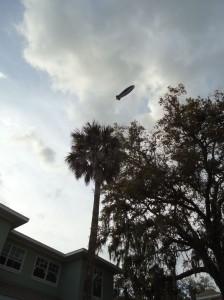I heard the roar of the engine, but it didn’t sound like a race car. I walked outside and looked up. There, a couple of hundred feet above the house was the Goodyear blimp. It’s not often you get an upclose and personal look at the blimp. We see a blimp at numerous sporting venues because it provides great aerial coverage. But here is was, cruising lazily over downtown Daytona, heading out towards the beach.
 I ran inside and grabbed a digital camera and set out in pursuit of the blimp. Before I got very far, two of the neighborhood children came running after me to see why I was looking up at the sky. I realized they weren’t going away, so I stopped and told them about the blimp. They were girls, about 10 years of age. they proceeded to tell me they had see it earlier and it was here of the race. I asked what race, and the looked at me with the disbelief of a child and said the Daytona 500. It’s tomorrow.
I ran inside and grabbed a digital camera and set out in pursuit of the blimp. Before I got very far, two of the neighborhood children came running after me to see why I was looking up at the sky. I realized they weren’t going away, so I stopped and told them about the blimp. They were girls, about 10 years of age. they proceeded to tell me they had see it earlier and it was here of the race. I asked what race, and the looked at me with the disbelief of a child and said the Daytona 500. It’s tomorrow.
I said I heard about it but didn’t know much. I said who do you want to win? They yelled Danica Patrick. When I asked why, one of them said because she’s a girl.
Until then, I hadn’t given much thought to the real significance of Danica Patrick’s achievement. Not only did she qualify as a driver, but she became the first woman to ever win the pole position in a NASCAR race. She did so with a speed of 199 mph.
I heard one of the radio sports guys belittling her achievement later Saturday evening.
On Sunday, as the race was nearing the midway point, I was in the car and a sports guy said Danica was in 9th place, in the middle of the pack where she usually was.
It really struck me how biased people are. They didn’t see the accomplishment of qualifying. They didn’t see the obvious point that even in 10th place, she was ahead of 33 of the boys.
She went on, as most people know, to place 8th, with an average speed of 158+ mph.
This video is built on a song written by August Wenger, the current President of the Daytona Music Society, and respected local historian. It’s called Thunder on the Beach and it’s a tribute to the racing pioneers who, beginning in the early 1900s, push the envelop with regard to automotive speed.
On of the men who died trying to top 200 mph was Lee Bible who crashed in 1929.
August revived a song called Tragedy on Daytona Beach written by Blind Andy Jenkins. To listen the Ballad of Lee Bible and watch a video, click here.